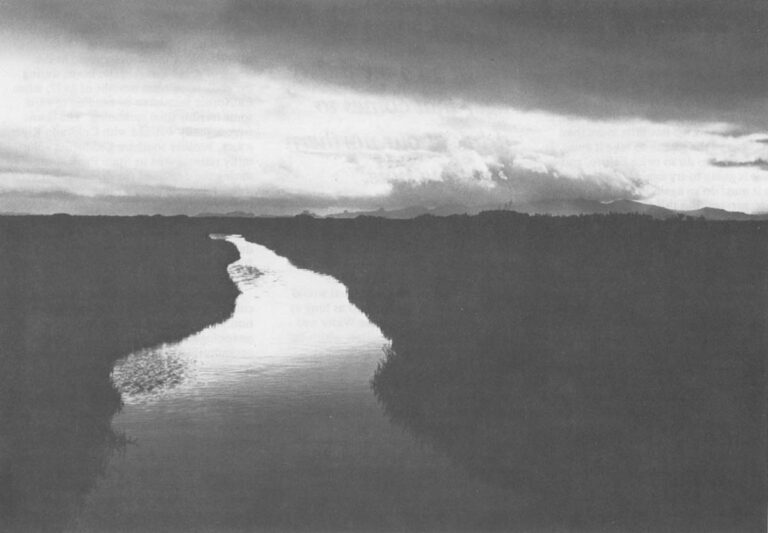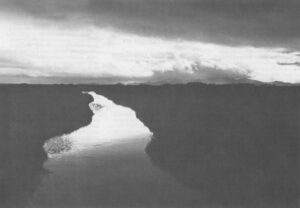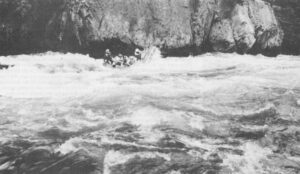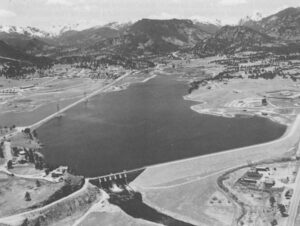In Los Angeles they had the votes and in the Central Valley they had the money, and so, over the strenuous but hopeless opposition of most of northern California, the inefficient water system which God designed for California was replaced by a much more efficient one designed by man. The transformation was wrought mainly by two immense water projects: the Central Valley Project, which, though begun over forty years ago, is still the most awesome hydrological engineering works in the world; and, in the 1960s and 1970s, the California Water Project, the largest engineering and financing scheme ever attempted by a single state. Both projects bring water from behind reservoirs in northern California over mountains, through tunnels, and across deserts to the southland. They rank with the engineering wonders of the world. And yet, as engineering projects, they share a peculiar weakness, a design element almost astonishing in its careless inefficiency. On its way south, all of the water is flushed through the Delta.

How many people, how many Californians even, have heard of the Delta, this place that holds-the phrase may seem farfetched at first, but isn’t-the future of California? Imagine two segments of sleek superhighway separated by a forty-mile jumble of dirt roads. There one has a crude allegorical image of the California water system today. The jumble of dirt roads is the Delta. A great marshland in the Central Valley, where the waters from the entire 600-mile length of the Sierra Nevada go into San Francisco Bay through the Sacramento and San Joaquin Rivers, the Delta is a riverine labyrinth of channels, sloughs, and backwaters separating marshes and low islands. Most of the islands have been levied and diked so that the soil, which is marvelously fertile, could be cultivated with alfalfa fields and orchards. Beside the levees, through the meandering channels, past the orchards and swishing bulrushes, goes the water upon which ten million people in the Los Angeles Basin depend for their lives.
The Delta serves quite adequately today as a natural conduit for the water of the Central Valley and State Water Projects, which enters it from the Sacramento River and is taken out by two river-sized aqueducts further south.
However, there is a catch: it can handle only about as much water as currently goes through it. And this puts the state in an extraordinary dilemma. By 1985, the densely populated South Coast will lose to Arizona more than half of the water it takes from the Colorado River-as much water as the three million people in Los Angeles proper now consume-and the State Water Project has signed contracts with southern California cities and irrigators that will force it nearly to double the amount of water it sends southward. In order to do so, it will have to drastically alter, or circumvent altogether, the Delta. In either case, it may give southern California an opportunity not only to destroy the Delta, but to increase, by an immense amount, the flow of water going southward. Northern California, therefore, sees the Delta in terms of symbolism. The Delta is to northern California what Leningrad was to Russia during the siege of 1941-1943, and it appears determined to protect it absolutely, and at all costs.
David Schuster is the chief of Operations and Maintenance Planning for all Bureau of Reclamation water projects in the agency’s Washington, D.C. headquarters. Until recently, he was the operations manager of the Bureau’s Central Valley Project-the man who sat at a vast computerized console in suburban Sacramento, and, by inserting cards and punching buttons, played God with the waters of California-so Schuster is one of perhaps two dozen people in the entire world who understand the hydrology of the Delta. Because he is no longer so directly involved in California water politics, and because, anyway, his reputation is that of an unusually candid and honest person in an agency renowned for its habitual deception, I called him in October and asked his feelings about the Delta and the future of the California water system.
“There is no question,” Schuster told me with some emphasis, “that the Delta is carrying water at capacity. The Delta is kind of like a straw in a chocolate malt: you can suck only so hard. If you tried to move much more than 11,000 cubic feet per second through it, which is about the current level, you’d suck the levees right in with it. The levees are extremely fragile. The earth they’re made of is essentially peat, and I personally doubt that they could withstand the pressures of increased flows through the channels. We’ve already had some collapse in 1972. If the levees begin collapsing, you risk inundating the Delta, because most of it is at or below sea level-it’s like Holland. And that of course, would be disastrous. For this reason alone, without changing the face of the Delta or circumventing it entirely, the whole State Water Project is stuck in second gear.
“But that isn’t all,” Schuster went on, “During drought years and in the summers of normal years, when the streams are trickling because irrigation demands are highest, a saltwater intrusion advances inland through the Delta toward Sacramento. To maintain the sweetness of the water you’re shipping southward, you have to push back the saltwater intrusion with additional fresh water releases. Both the Bureau and the state release water to maintain water quality. However, the state is in a real fix, because it’s already signed contracts to sell more water than it has to deliver, and-at the same time-it’s got a clearer legal obligation to protect Delta water quality than the Bureau does. Obviously, the state has to be wondering how it’s going to fulfill it’s contractual obligations to deliver water to cities and irrigators and honor its legal obligation to maintain water quality in the Delta.
“A third problem with the Delta is reverse flows,” continued Schuster. “As you pump water across the Delta channels toward the pumps at the southern end, you invariably suck some salt water along with it. The more you pump, the worse it gets. This problem-reverse flows-is not quite the same as the saltwater intrusion problem, and it gets kind of complicated, but the point is this: even if the state did a whole lot of channel work and strengthened the levees so it could pump more water through the Delta, it would still have to worry about the reverse flows.
“To all of this you have to add the problem of the fishery. The Delta supports an important anadromous fishery, and the unnatural flows across the channels are hurting it badly. No one really knows exactly how salmon and striped bass find their spawning streams, but somehow they seem to smell or sense the right river, and we’ve mixed everything up for them. So they aren’t spawning.
“What California is left with, then, is some very hard choices,” Schuster concluded. “They could do nothing, but to southern California that would be unthinkable. So, if we assume that the state will ship more water to southern California, there are two alternatives. They can do major channel work in the Delta and strengthen the levees, but that has several drawbacks: it might cost a great deal, you can’t tell what it’s effects might be on the whole Delta, and it doesn’t solve the fish problem or the reverse flows. The other alternative is to build the Peripheral Canal.”
During the past two years, the most contested issue in the fractious world of California politics, apart from the death penalty and Proposition 13, has been a proposal by the Brown Administration and southern California legislators to build a 600-million dollar, 400-foot wide, forty-three mile ditch circumventing the Delta. Although it is a project of potentially enormous implications, it would be called, quite simply, the Peripheral Canal. Normally parsimonious legislators and California’s era-of-limits governor have pushed the canal, together with several billion dollars worth of water storage projects designed to double the yield of the State Water Project, harder than anything else on the Brown Administration’s legislative agenda. Brown designed his Peripheral Canal bill to please everyone-irrigators, environmentalists, the Delta interests, urban areas north and south-but in the end it has satisfied nobody, and has gotten nowhere.
That the Peripheral Canal has gotten nowhere reflects with crystalline clarity the fact that “California” is a wholly arbitrary political invention. When one looks at the state with a geopolitical eye, an invisible boundary materializes between San Francisco and Lake Tahoe-where green fades to brown on a hydrographic map-and suddenly there are two Californias. Northern California has the only resource that really matters in the arid West: water. Southern California has little more than the votes and the wealth to take it away. It has managed to do so twice before, and now it is going to try again says, indeed, that it must do so again in order to grow, if not to survive. But this time an embittered and determined northern California-a northern California which is, to an increasing degree, culturally alien-has engaged it in political trench warfare, and has fought the Peripheral Canal to a frozen stalemate.
To southern California, and to a small number of northern Californians (most of whom are fishermen), the Peripheral Canal makes a great deal of sense, because it would eliminate most of the problems associated with shipping water through the Delta. The reverse flows of salt water would no longer plague the operation of the State Water Project. The salt-water intrusions could be effectively controlled by releases from the canal into the Delta at a variety of locations. The damage to the Delta fishery would, in theory, be curtailed, perhaps eliminated. And the canal’s vast capacity-22,300 cubic feet per second, a flow equivalent to the Hudson River-would permit the amount of water going southward to double, which would, in turn, allow more of the Los Angeles basin to be covered with tract houses, and permit more of the Lahonton Desert to be converted to alfalfa fields.
In return, there would be, under the Brown plan, “absolute” guarantees to the Delta of sufficient water at all times for its needs. There would be protection for several magnificent un-dammed rivers on the North Coast-rivers whose “waste” of unused water into the Pacific Ocean is the cause of much agonized frustration among the Central Valley irrigators. And there would be at least the beginnings of a program of conservation and groundwater management. The Brown people say to northern California and the conservationists that it is the best deal they are going to get, that the Peripheral Canal will be built and they will get nothing at all if it is built only after southern California runs out of water.
But northern Californians are not listening, or if they are listening they are not buying the argument. Some of their most powerful elected representatives, such as Congressman George Miller of Contra Costa County (which encompasses the Delta) and State Senator Peter Behr, continue to bedevil all efforts to get the Peripheral Canal built, with some help from southern California legislators who consider Brown’s bill too conservation oriented. Miller’s chief aide, John Lawrence, told me that the Canal would never be built with Federal aid as long as Miller remains on the House Water and Power Resources Subcommittee, which he has every intention of doing. Even if California tried to build the canal without federal aid, he told me (in desperation, that is what the state is now trying to do) Miller might be able to throw down some formidable obstacles.
“Our colleagues in the valley and the south own the thirsty tiger that comes to drink at our northern watering holes,” said State Senator Behr in 1978 after the Peripheral Canal went down to one of its several defeats in the legislature. The “paper cage” that the Brown Administration built for the tiger, added Behr, would not contain it should it develop an unquenchable thirst. What he meant, of course, is that once the plumbing is in place to bring more of northern California’s water southward, it will surely come-just as freeways, no matter how large, seem eventually to fill up with traffic. Since the canal is twice as large as it needs to be today, it is designed for enormous growth in southern California, and, as such, is regarded by most environmentalists as a “loaded gun” pointed at the North Coast rivers.
Notwithstanding all the guarantees in the world, says northern California, the needs of the Delta or the integrity of the North Coast Rivers would be as nothing compared with the economic and political significance of southern California running out of water during a drought. The Brown Administration has not offered, and, indeed, cannot offer absolute protection for the North Coast Rivers. Even contractual obligations to provide water to the Delta could be broken during a drought and the damages reimbursed-a small price to pay if thirteen million southern Californians and billions of dollars worth of fruits and vegetables were withering away. Voting for the Peripheral Canal, says northern California, would be like voting for the Gulf of Tonkin Resolution.
The alternative, which northern Californians propose to their brethren to the south, is more conservation and less growth. Bitter memories remain in the north of green Los Angeles lawns during the endless, rainless months of 1977, when California seemed to be heading toward some terrible final reckoning. The lawns were actually watered with Colorado River water, because southern California voluntarily relinquished its State Project water during the depths of the drought, but even if this fact were known among northern Californians, and it isn’t, it probably wouldn’t matter much anyway. If we reduced our consumption by up to 60 percent during the drought, says northern California, why cannot southern California do even half as well?
But conservation is a boring idea in a culture, which has, not without justification, acquired a reputation for unapologetic indulgence. And to the agricultural interests conservation means new and expensive irrigation systems, which require more labor, and that means more power to the dreaded Cesar Chavez. Yet conservation is infinitely more palatable than the idea of stopping growth; to the hard-bitten agricultural businessmen of the Central Valley, being against growth is like being for communism or incest. “People like Jerry Brown and the environmentalists didn’t make this country great,” said a contemptuous Bill Dubois, a former Imperial Valley farmer who is now head of the state’s most powerful agricultural lobby, when I interviewed him last spring. “All they worry about is the river rafters and the fish. Well, to hell with the fish. We’ve got to keep stuffing the marketplace with the things people want. That’s what makes this country great.”
Can a marshland determine the future of California? Perhaps it can, if it separates not only two parts of the state but two regions with separate economies, cultures, and identities. Perhaps it can, if northern California continues to view the Peripheral Canal as southern California’s final solution, and if it continues to resist the southland’s intentions even under virtual siege, as it did last year in the legislature. But northern California surely realizes that denying southern California water is like denying petroleum to the oil-starved nations of the industrialized world. As we know from the oil embargo, such a policy risks-indeed, invites- invasion, and it will be interesting to see when it will come, and in what form.
©1979 Marc Reisner
MARC REISNER is continuing his fellowship investigation into the Effects of the Federal Government’s Water Resources Policies on the Nation.






